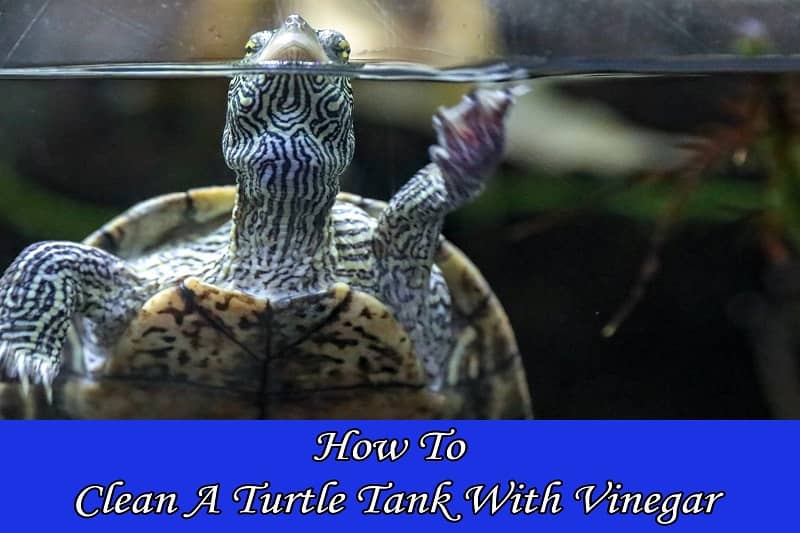White vinegar has been a pantry essential for many years. But did you know you can use white vinegar to clean your turtle tank? Turtle tank cleaners can be expensive, and cheaper ones might not do the job correctly. It is why many turtle owners prefer using white vinegar as a cleaner.
White vinegar has a pH of 2.5. It is a strong acid. Acetic acid, the main ingredient of white vinegar, helps to dissolve and break the algae stains inside the turtle tank easily. Hard water often leaves residue around the tank, which white vinegar can clean easily.
So, white vinegar can clean algae, mineral stain and work as a water disinfectant inside the turtle tank. All these reasons make white vinegar a great turtle tank cleaner.
A small amount of white vinegar is not harmful to your turtle. But, finding the correct method can be confusing. We will tell you how to clean a turtle tank with vinegar in today’s write-up.

How To Clean A Turtle Tank With Vinegar?
To clean a turtle tank with vinegar, you will need white vinegar, cleaning sponges, a scraper or a razor blade, and table salt to scrub. White vinegar can clean the outer perimeters of the tank as well.
Here is an easy guide on how to clean a turtle tank with vinegar:
1. Remove The Turtle
Before you start the cleaning process, pick and remove your turtle. Keep the turtle in a big enough bucket filled with water to let it swim freely. Often people use a separate tank/container to feed their turtles in, so if you have one of these, use that.
2. Remove The water And Empty The Insides Of The Tank
Start with removing a part of the water in the tank. Move on to turning off and removing the electric devices of the tank. Remove the basking area and décor. Keep these aside to clean later. Once you have emptied the inside, proceed to remove all the water inside.
Removing the insides in sections is recommended by us because a turtle tank is heavy. With the additional water weight and items, it can be hard to carry around.
3. Scrub The Inside
Often people prefer wetting the stains before proceeding with scrubbing. We recommend soaking the cleaning sponge in water and using table salt before you start scrubbing. It will clean up algae and easy to get rid of the stain. It will also loosen stains.
4. Soak In White Vinegar
Mix equal parts of water and white vinegar in a bucket. Soak the cleaning sponge in the water and vinegar mixture and scrub the tank with it. Do not rinse the vinegar and let it sit for 10-20 minutes.
Many like to clean the tank with table salt before using the vinegar mixture, but many prefer to do it afterward. We recommend using salt to scrub before using vinegar.
5. Scrap Leftover Stains
Once the tank has been soaked in vinegar, clean again with a sponge, and then rinse. Soak the cleaning sponge in the vinegar mixture. This time target all the leftover stain, calcium deposit, and algae build up and start scrubbing
6. Rinse Thoroughly
By this time, all the removable stains should be gone. Rinse the tank thoroughly and then proceed to dry it completely.
7. Soak The Décor In Vinegar
Move onto cleaning the décor after you have cleaned the tank. Cleaning the décor is important because there will be algae stuck on those. Putting the decor back inside as it is might cause more harm. To clean the décor, soak it into the 1:1 vinegar and water mixture. Let that soak for 10 to 15 minutes.
8. Scrub, Clean, And Rinse Thoroughly
Use a toothbrush to scrub the décor thoroughly. It might be harder to clean so, scrub gently without tiring yourself out. If it is harder to clean, dip the brush in pure vinegar. Rinse and dry before putting it back inside the turtle tank.
Things To Be Careful Of While Cleaning A Turtle Tank
As we have mentioned before, a small amount of white vinegar is not necessarily harmful to your turtle. Here are a few things you should be careful of while using white vinegar to clean a turtle tank:
- Always remove and keep your turtle away while you are cleaning the tank.
- When removing the turtle from the tank before cleaning, wearing a pair of gloves is recommended. Turtles carry salmonella and, it is a must that you take enough precaution.
- After cleaning the tank, be sure to dry it thoroughly before putting your turtle inside. You might wonder, you are going to fill the tank with water again. So why should you dry it completely? This step is needed because it ensures there’s no vinegar or any cleaner left inside the turtle tank.
- If you have a plastic or acrylic turtle tank, gently scrub on the stain. Hard water stains and calcium deposits are hard to get rid of, but relentlessly scrubbing will scratch the surface of the tank.
- If you have a plastic or acrylic turtle tank, avoid using razor blades or toothbrushes to scrap hard to get rid of the stain.
- Emptying the tank is the first step of cleaning. But returning all the items you have removed in their original place is just as important. Without the usual placement, there is a chance your turtle will feel disoriented once it goes back to the tank post-cleaning.
- Cleaning the filter and heater is a must too. When cleaning the filter, follow the instructions provided with it. When cleaning the heater, clean the outside with a cloth and gentle wiping movements.
- If you are cleaning the tank area in a different place from where it sits, then carrying the empty tank to the display area is a great idea. Filling it with water and then taking it back may cause any unexpected accidents.
Is Vinegar Harmful For Turtles?
Cleaning the turtle tank with vinegar is fine as long as you keep the turtle away from the tank and the vinegar. Before you put the turtle back inside, make sure there is no vinegar residue left.
Is Cleaning A Turtle Tank Important?
A clean tank ensures a healthy and happy turtle. On the other hand, an uncleaned tank leads to cloudy and smelly water leading to your turtle getting ill. A turtle eats, lives, and defecates in the same water. That is why it is a necessity to change the water and clean the tank regularly.
Turtles carry salmonella. Without a clean tank and freshwater inside, a salmonella outbreak is just one of the bad things that might occur. If your turtle tank has lights or stays in sun exposure, it needs proper cleaning and water change. Or else there will be an algae overgrowth within days.
How Often Should You Clean A Turtle Tank?
Clean the entire tank every two to three weeks. A water change should happen once every week. Remember to change only 30% of the water and replace it with fresh water. It will ensure a clean habitat for your turtle and keep away algae overgrowth as well.
Do not wait until the water inside is murky because this means your turtle is already feeling uncomfortable. Cloudy water means the nitrate level is getting higher inside the tank.
How To Keep A Turtle Tank Clean?
Despite the easy cleaning steps, cleaning a turtle tank twice a month is hard. There are a few steps you can take to lessen the dirt in the tank. It will ensure that you don’t have to frequently clean and change the water.
- Adding a few live plants inside the tank will ensure an algae-free environment. These plants will starve algae, leading to an algae-free turtle tank. Use a floating plant if you don’t have substrate in the tank. Be sure to check whether it is toxic to the turtle or not.
- Leftover food can cause quite a disruption in hygiene. If you have a friendly turtle, then adding fishes that eat algae will keep the tank cleaner. Those fishes will feed on algae and the leftover food sitting at the bottom. Chances are your turtle might eat that fish, so adding cheaper fishes is recommended. Ghost shrimps are perfect for scavenging the leftover food from the bottom. Turtles love to eat ghost shrimps. And they are inexpensive as well. Add a few ghost shrimps in the tank to keep it cleaner.
- if you don’t want to add extra fishes, then clean the leftover food manually. Use a net to take it out of the tank. Letting it rot in the water will lead to frequent clean-up.
- Use a strong filter for the turtle tank. A better filter means a cleaner turtle tank. Aerate the water inside. Doing this will keep away bacteria and reduce cleaning hassle for you.
- If possible, keep a different feeding area for a turtle.
A separate feeding area ensures the water your turtle is living in is cleaner, leaving you with a cleaner tank. If this is a hassle, you can use a net to scoop the leftover food after each feeding.
Final Words
White vinegar is a widely available organic turtle tank cleaner. Using vinegar to clean your turtle tank ensures a cleaner tank and a happier turtle. If possible, keep the turtle tank free of hard water.
Doing this will allow the tank to stay unspoiled and prevent mineral stains. After each cleaning session, do not forget to wash your hands properly.
